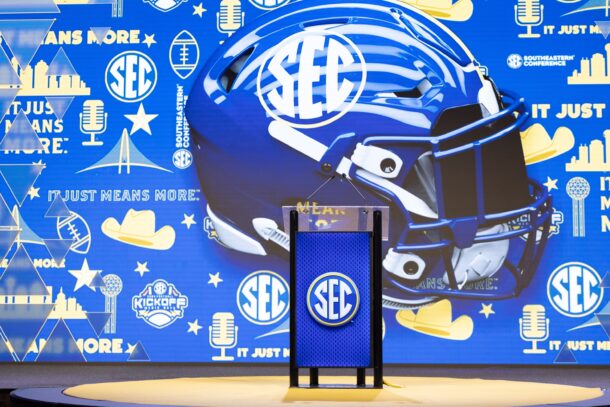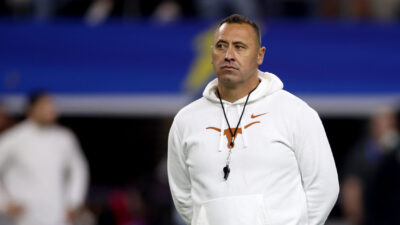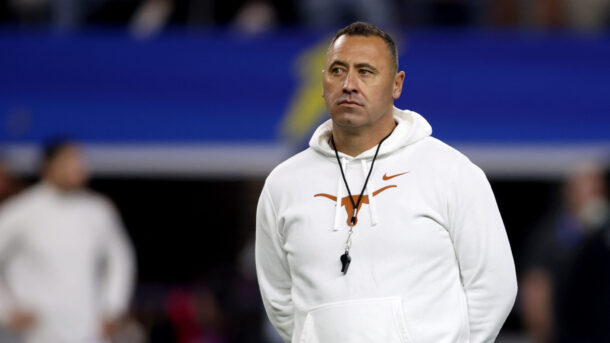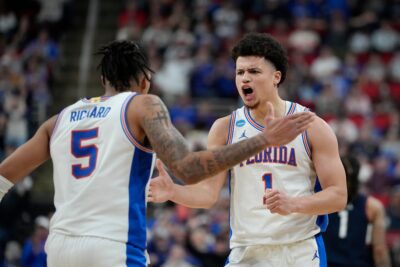Ad Disclosure
Like a home run chase in baseball or the scoring title in basketball, college football features its own “games within the game” as players chase statistical milestones or the top totals in their conference or even the country.
Sometimes these men hail from the same team, competing for a common good but also competing against one another for locker room bragging rights. Other times it conveniently works out that the players in question compete for longtime rivals, adding fuel to the fire of hatred between the two schools.
Through the years, the SEC has hosted a number of these battles, be it between teammates or conference foes. In honor of Running Backs Week at SDS, here are our top tailback battles through the years, broken down into the two categories discussed above.
Two men, one team
Cadillac Williams vs. Ronnie Brown (2004)
Williams stats: 239 carries, 1,165 yards (No. 2 SEC), 4.9 yards per carry, 12 touchdowns
Brown stats: 153 carries, 913 yards (No. 7 SEC), 6.0 yards per carry, 8 touchdowns
Recap: Williams already had a 1,000-yard season under his belt when Auburn’s 2004 campaign began, earning him a starting job and 86 more carries on the year than Brown, who had more success in the NFL than in any season shared with Williams at Auburn. The two worked together brilliantly, leading Auburn to an undefeated season that was cheated out of the BCS title game. Williams produced more, but Jones did more with his limited number of carries. Still, you’d have to give the edge to Williams, who was on his way to becoming one of the NFL’s top backs before injuries intervened.
Darren McFadden vs. Felix Jones (2006-07)
McFadden stats: 609 carries, 3,477 yards, 5.7 yards per carry, 30 touchdowns
Jones stats: 287 carries, 2,330 yards, 8.1 yards per carry, 17 touchdowns
Recap: McFadden and Jones both played three years at Arkansas, entering together in 2005 and exiting together as first-round NFL draft picks in 2007. McFadden ran for 1,000 yards as a freshman while Jones added more than 600, but it wasn’t until 2006 that both truly hit their stride. McFadden ran for more than 1,600 yards in each of those two seasons, carrying the ball nearly three-times as often as Jones. However, Jones still amassed more than 1,100 yards in both seasons, doing so at a ridiculous clip of more than eight yards a carry. The two shared the field when Arkansas introduced its “WildHog” package, with McFadden playing option quarterback and Jones sweeping across as a second threat on every snap. If the selection to let McFadden engineer that package is any indication, he closes with a slight edge over his teammate in this battle.
Jonathan Williams vs. Alex Collins (2014)
Williams stats: 211 carries, 1,190 yards (No. 4 SEC), 5.6 yards per carry, 12 touchdowns
Collins stats: 204 carries, 1,100 yards (No. 5 SEC), 5.4 yards per carry, 12 touchdowns
Recap: While this may not satisfy those of you who crave definitive winners and losers, this battle that took place just last year is as genuine a draw as there ever was. The two split 415 carries almost exactly down the middle in 2014, finishing within 100 yards of one another with near-identical yards per carry averages and equal touchdown totals. The two both finished in the top 5 in the SEC in rushing, and both are slated to return this fall for another go-round in Oxford. If Bret Bielema’s coaching history is any indication, these two have a great shot at both topping 1,000 yards again in 2015.
SEC rivalries
Herschel Walker vs. George Rogers (1980)
Walker stats: 274 carries, 1,616 yards, 5.9 yards per carry, 15 touchdowns
Rogers stats: 297 carries, 1,781 yards, 6.0 yards per carry, 14 touchdowns
Recap: Rogers and the South Carolina Gamecocks were still a dozen years away from joining the SEC, but that didn’t stop he and Herschel Walker from battling for the title of the nation’s top running back in 1980. Walker burst on the college scene as a true freshman, even though his 1,600 yards that year would turn out to be his career-low as a Bulldog. Rogers was just as sensational, following 1,000-yard seasons in 1978 and ’79 with more than 1,700 yards in his final season as a Gamecock. Rogers won the Heisman, while Walker finished third (he won the award in 1982), which should indicate who won this particular battle.
Bobby Humphrey vs. Brent Fullwood (1986)
Humphrey stats: 236 carries, 1,471 yards (No. 1 SEC), 6.2 yards per carry, 15 touchdowns
Fullwood stats: 167 carries, 1,391 yards (No. 2 SEC), 8.3 yards per carry, 10 touchdowns
Recap: It’s no secret Alabama and Auburn do not like one another, which is what made this battle between Humphrey and Fullwood in 1986 so satisfying. Humphrey held an 80 yard edge, but required 69 additional carries to amass that advantage. He finished as that season’s rushing champ as his Crimson Tide closed the year with a 10-3 record, a half-game worse than 10-2 Auburn, led by Fullwood. The Tigers’ star back nearly stole the rushing title, but still managed to impress with an average of more than eight yards per carry. Ultimately Fullwood earns the edge not because of his incredible yards per carry average, but because he ran for 1,300 yards and finished second in the SEC in rushing as the Bo Jackson’s successor in the backfield, which is no easy role to fill.
Fred Taylor vs. Jamal Lewis (1997)
Taylor stats: 232 carries, 1,364 yards (No. 1 SEC), 5.9 yards per carry, 7 touchdowns
Lewis stats: 214 carries, 1,292 yards (No. 2 SEC), 6.0 yards per carry, 13 touchdowns
Recap: Before these two backs went on to NFL greatness (Lewis is one of seven players all-time to post a 2,000-yard season, while Taylor ranks in the top 20 on the NFL’s all-time rushing list), they were SEC rivals at two of the conference’s longtime powers: Florida and Tennessee. They finished 1-2 on the SEC rushing list in 1997, posting almost the same yards per carry averages with the difference in their rushing totals lying in Taylor’s 18 additional carries. Lewis was just as productive with nearly the same amount of work under his belt, and he ran for nearly twice as many touchdowns as Taylor, although Lewis had the benefit of senior Peyton Manning leading the offense. Both were put in good situations to succeed and both did just that, so the tie goes to Lewis and his 13 touchdowns on the year, more than one per game.
Anthony Dixon vs. Dexter McCluster (2009)
Dixon stats: 257 carries, 1,391 yards (No. 2 SEC), 5.4 yards per carry, 12 touchdowns
McCluster stats: 181 carries, 1,169 yards (No. 5 SEC), 6.5 yards per carry, 8 touchdowns
Recap: Dixon and McCluster may have both finished in the top 5 on the 2009 SEC rushing list, and both may have starred for opposing in-state rivals in Mississippi State and Ole Miss, but their playing styles couldn’t have been any more the opposite. Dixon was a physical runner known for picking up tough yards and his nose for the end zone. His durability and powerful running resulted in nearly 1,400 yards, but that was nearly outdone by the more than 1,100 yards posted by McCluster on 76 fewer carries. McCluster averaged 1.1 yards more per carry than Dixon, and he spent half the season serving as a wideout due to his versatility and athletically based skills set. His receiving numbers blew Dixon’s out of the water, and Dixon only narrowly out-rushed McCluster, albeit on a far inferior team in Dan Mullen’s first season in Starkville. Still, the edge goes to McCluster for his ability to rush for more than 1,100 yards in addition to everything else he did on that year’s Ole Miss offense.
A former newspaper reporter who has roamed the southeastern United States for years covering football and eating way too many barbecue ribs, if there is such a thing.




